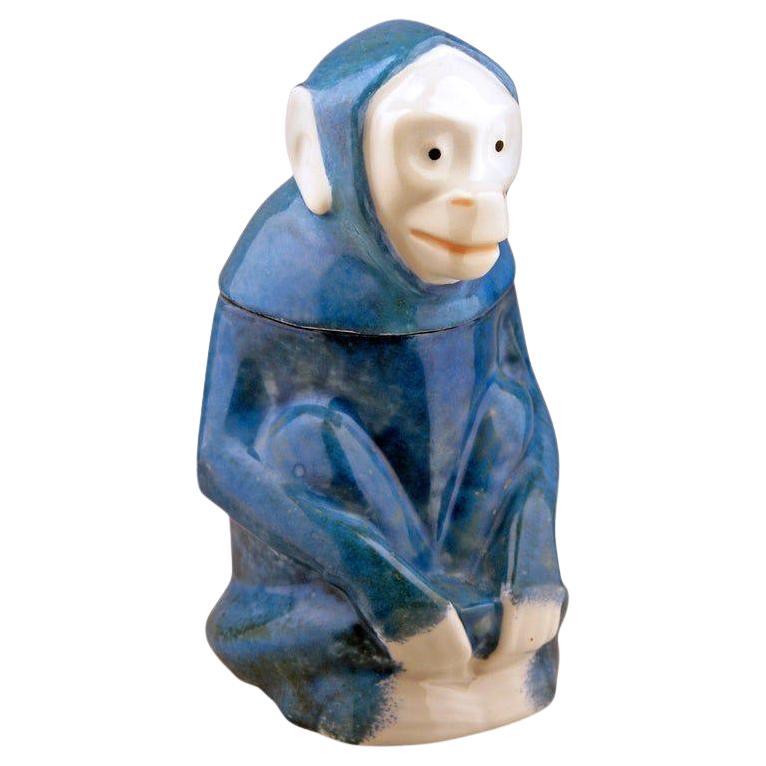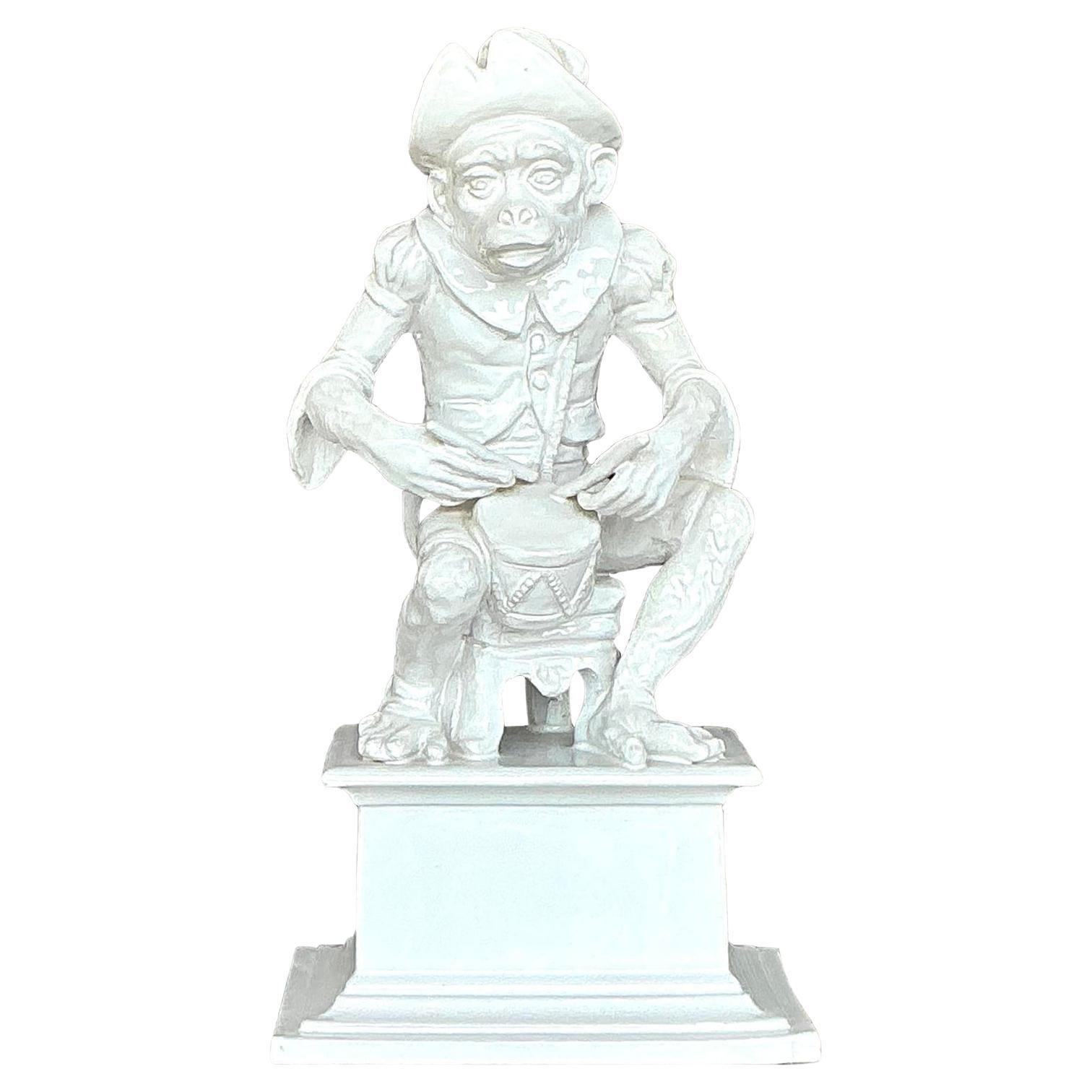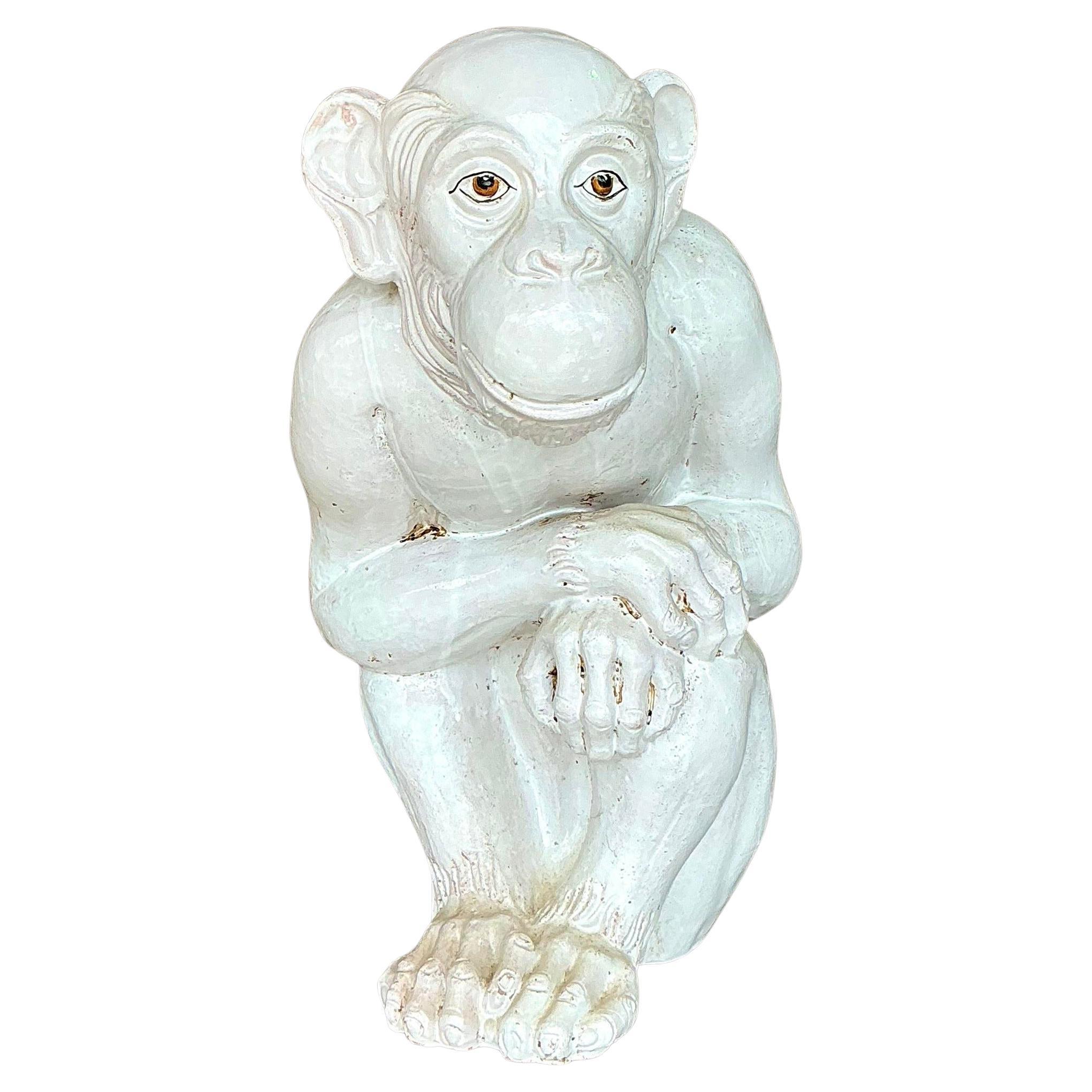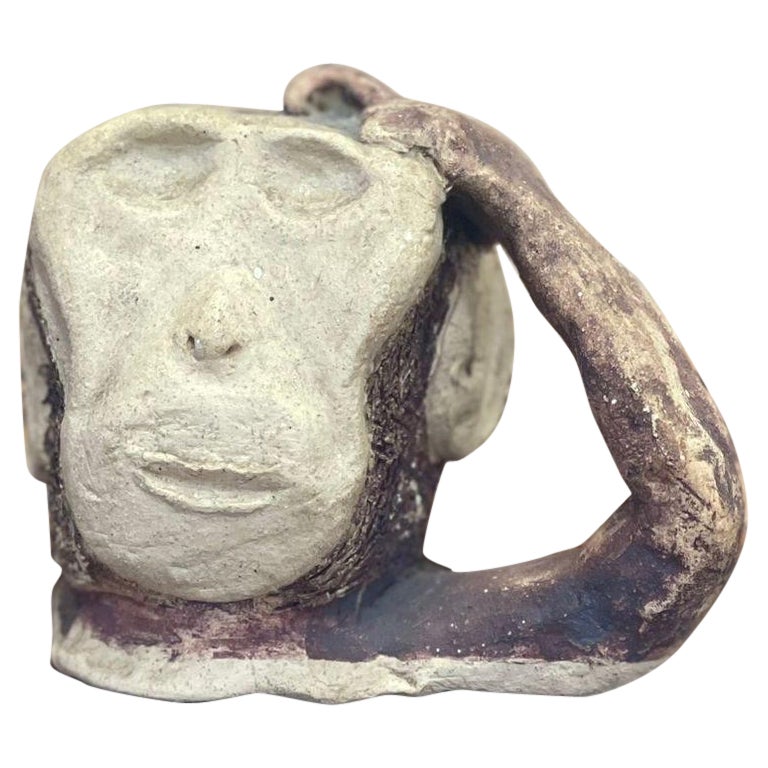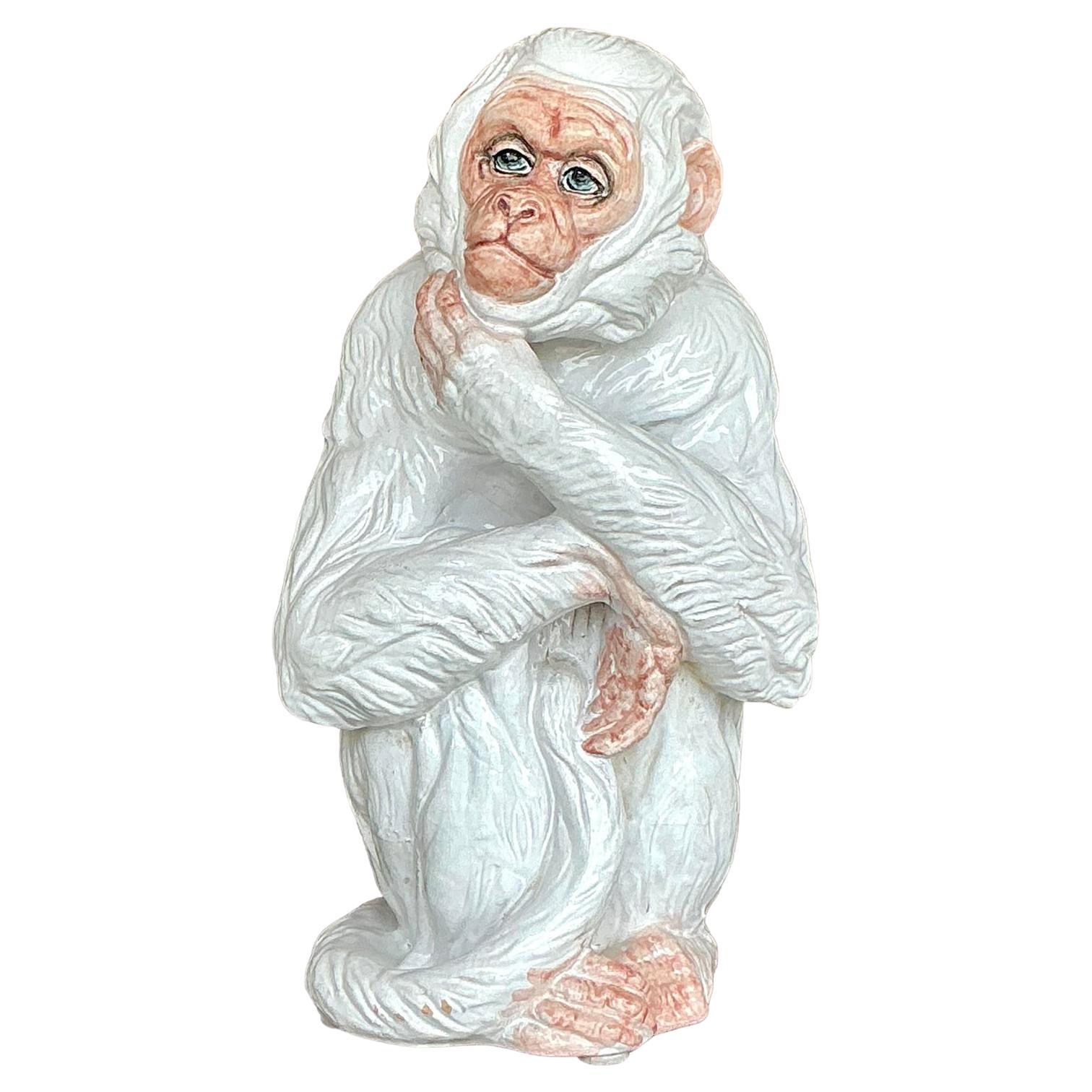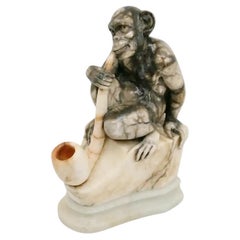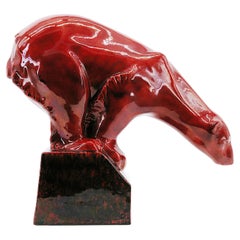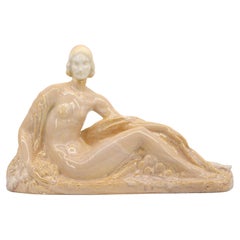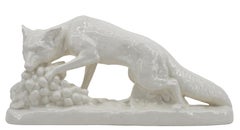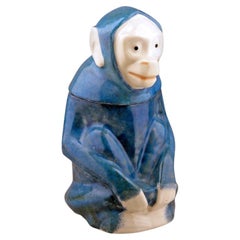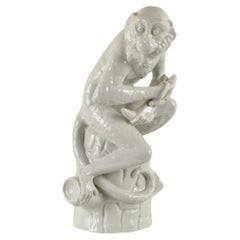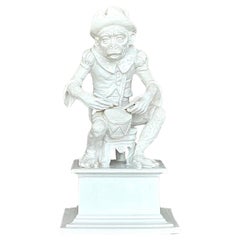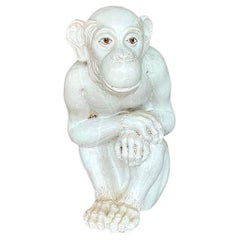Items Similar to ODYV French Art Deco Ceramic Monkey, 1920
Video Loading
Want more images or videos?
Request additional images or videos from the seller
1 of 11
ODYV French Art Deco Ceramic Monkey, 1920
$2,000
£1,484.08
€1,728.75
CA$2,784.01
A$3,100.25
CHF 1,613.51
MX$38,225.72
NOK 20,549.28
SEK 19,314.33
DKK 12,898.60
Shipping
Retrieving quote...The 1stDibs Promise:
Authenticity Guarantee,
Money-Back Guarantee,
24-Hour Cancellation
About the Item
This French Art Deco crackle glaze ceramic sculpture by BERLOT-MUSSIER, created in the 1920s in Vierzon, France, features a monkey in a playful and stylized pose. The sculpture stands at 6.4 inches (16.3 cm) tall, 6.9 inches (17.5 cm) in width, and 4.1 inches (10.5 cm) in depth, making it a compact and striking decorative piece.
The "Odyv" mark under the base indicates it was made by the Odyv studio, which was part of the Vierzon pottery factory during this time. The crackle glaze finish, a hallmark of the Art Deco period, gives the piece a textured, visually dynamic surface.
The monkey figure captures the playful, whimsical nature of the era, with its geometric forms and stylized features. The sculpture’s charming design, combined with its quality craftsmanship, makes it an intriguing addition to any collection of Art Deco ceramics.
- Creator:ODYV (Maker)
- Dimensions:Height: 6.42 in (16.3 cm)Width: 6.89 in (17.5 cm)Depth: 4.14 in (10.5 cm)
- Style:Art Deco (Of the Period)
- Materials and Techniques:
- Place of Origin:
- Period:
- Date of Manufacture:1920
- Condition:
- Seller Location:Saint-Amans-des-Cots, FR
- Reference Number:1stDibs: LU2312344075892
About the Seller
5.0
Platinum Seller
Premium sellers with a 4.7+ rating and 24-hour response times
Established in 2003
1stDibs seller since 2016
484 sales on 1stDibs
Typical response time: 1 hour
- ShippingRetrieving quote...Shipping from: Saint-Amans-des-Cots, France
- Return Policy
Authenticity Guarantee
In the unlikely event there’s an issue with an item’s authenticity, contact us within 1 year for a full refund. DetailsMoney-Back Guarantee
If your item is not as described, is damaged in transit, or does not arrive, contact us within 7 days for a full refund. Details24-Hour Cancellation
You have a 24-hour grace period in which to reconsider your purchase, with no questions asked.Vetted Professional Sellers
Our world-class sellers must adhere to strict standards for service and quality, maintaining the integrity of our listings.Price-Match Guarantee
If you find that a seller listed the same item for a lower price elsewhere, we’ll match it.Trusted Global Delivery
Our best-in-class carrier network provides specialized shipping options worldwide, including custom delivery.More From This Seller
View AllAlabaster Monkey Sculpture, End 19th C
Located in Saint-Amans-des-Cots, FR
French Alabaster Sculpture, France, Late 19th Century – Monkey Smoking a Pipe. This delightful French alabaster sculpture, created at the end of the 19th century, depicts a monkey leisurely smoking a pipe. The sculpture is crafted in alabaster, with intricately detailed features that capture the playful yet thoughtful expression of the monkey. Notably, the eyes are made of glass, adding a unique touch of realism to the piece.
Dimensions: Height: 9.8" (25 cm), Width: 6.7" (17 cm), Depth: 4.4" (11.2 cm). The sculpture is in good condition, with only slight scratches and small chips on the base, which are consistent with age.
A whimsical and charming example of late 19th-century French sculpture, this piece would make an intriguing addition to any collection of animal-themed art or antique stone...
Category
Antique 1890s French Napoleon III Animal Sculptures
Materials
Alabaster
Paul Milet Sevres French Art Deco Stoneware Bear, 1920
Located in Saint-Amans-des-Cots, FR
French Art Deco stoneware bear by Paul MILET, 8, rue Troyon, Sèvres, France, 1920s. Height : 32.5cm - 12.8 in. , Width : 34cm - 13.4 in., Depth : 13.5cm-5.3in. A pinhead lack of cove...
Category
Vintage 1920s French Art Deco Animal Sculptures
Materials
Ceramic, Stoneware
French Art Deco Ceramic Lady by ODYV, 1920
By ODYV
Located in Saint-Amans-des-Cots, FR
French Art Deco ceramic sculpture by BERLOT-MUSSIER (Vierzon), France, 1920s. Young Lady among flowers in the style of René Buthaud in colored crackle glaze ceramic. Measures: Height...
Category
Vintage 1920s French Art Deco Figurative Sculptures
Materials
Ceramic
French Art Deco Ceramic Fox by Gustave Gillot for Odyv, 1920
By ODYV, Gustave Gillot
Located in Saint-Amans-des-Cots, FR
French Art Deco ceramic fox sculpture by Gustave Gillot (1888-1965) for Berlot-Mussier), France, 1920s. Illustration of the fable "The Fox and the Grape" by Jean de La Fontaine. Heig...
Category
Vintage 1920s French Art Deco Animal Sculptures
Materials
Ceramic
DAX Ceramic Polar Bear, 1920
Located in Saint-Amans-des-Cots, FR
French Art Deco polar bear by Dax, France, 1920s. Width: 16.3"(41.5cm), Height: 8.4"(21.4cm), Depth: 4.8"(12.2cm). Excellent condition
Category
Vintage 1920s French Art Deco Animal Sculptures
Materials
Ceramic
Moulin-des-Loups, Orchies, Art Deco Ceramic Lion Statue, 1920
By Orchies
Located in Saint-Amans-des-Cots, FR
French Art Deco Lion Statue by Moulin-des-Loups (Orchies), France, 1920s.This rare and striking ceramic lion statue, crafted by the renowned Moulin...
Category
Vintage 1920s French Art Deco Animal Sculptures
Materials
Ceramic
You May Also Like
Art Deco porcelain monkey tabacco box
By Edouard-Marcel Sandoz
Located in Buenos Aires, Argentina
Art Deco porcelain monkey tabacco box
Hand-glazed and hand-painted, created by Edouard-Marcel Sandoz and manufactured by Theodore Haviland
By: Edouard-Marcel Sandoz, Theodore Havila...
Category
Vintage 1920s French Art Deco Snuff Boxes and Tobacco Boxes
Materials
Enamel
KPM Blanc de Chine Monkey Sculpture, Germany 1960s
By KPM Porcelain
Located in Norwalk, CT
Made by the KPM, Real Porcelain Factory in Berlin, Germany, this beautifully crafted figure features a monkey eating bananas. The attention to detail and fine glaze are outstanding. ...
Category
Vintage 1960s German Hollywood Regency Animal Sculptures
Materials
Porcelain
Vintage Italian Glazed Ceramic Monkey
Located in West Palm Beach, FL
Channeling playful elegance and old-world charm, this vintage Italian glazed ceramic monkey drummer sculpture is a whimsical work of art. Dressed in a period-style costume complete w...
Category
Mid-20th Century Italian Mid-Century Modern Animal Sculptures
Materials
Ceramic
$1,320 Sale Price
20% Off
Vintage Italian Glazed Ceramic Life Size Monkey
Located in West Palm Beach, FL
Elevate your interior with this eye-catching, life-size Italian glazed ceramic monkey. Expertly crafted, this stunning piece features lifelike details and a sleek, glossy finish, mak...
Category
Mid-20th Century Italian Animal Sculptures
Materials
Ceramic
$1,480 Sale Price
20% Off
Hand made Vintage Ceramic Signed Monkey Sculpture
Located in Seattle, WA
Hand made Vintage Ceramic Signed Monkey Sculpture Rendering Abstract Art Décor Brown, White
Dimensions. 6 W ; 4 1/2 D ; 4 1/2 H
Category
Vintage 1970s Art Deco Abstract Sculptures
Materials
Ceramic
$116 Sale Price
20% Off
Vintage Italian Glazed Ceramic Monkey
Located in West Palm Beach, FL
Add whimsical sophistication to your space with this vintage Italian glazed ceramic monkey sculpture, masterfully crafted with expressive detail and striking realism. The soulful gaz...
Category
Mid-20th Century Italian Mid-Century Modern Animal Sculptures
Materials
Ceramic
$1,480 Sale Price
20% Off
More Ways To Browse
Art Deco Compacts
Antique Crackle Glaze
French Art Deco Pottery
Antique French Ceramic Marks
Animal Ceramics
1920s Compact
Gray Pottery Art Deco
Art Deco Crackle Glaze Ceramic
Whimsical Ceramics
French Art Deco Crackle Glaze
16 Pesci
1960 Italian Couple Of Cats
1970s Toy Hippo
Abercrombie Duck
Abercrombie Fitch Duck
African Ebony Wood Hand Carved Elephant
Alabaster Cockatoo
Aldo Tura Fish
